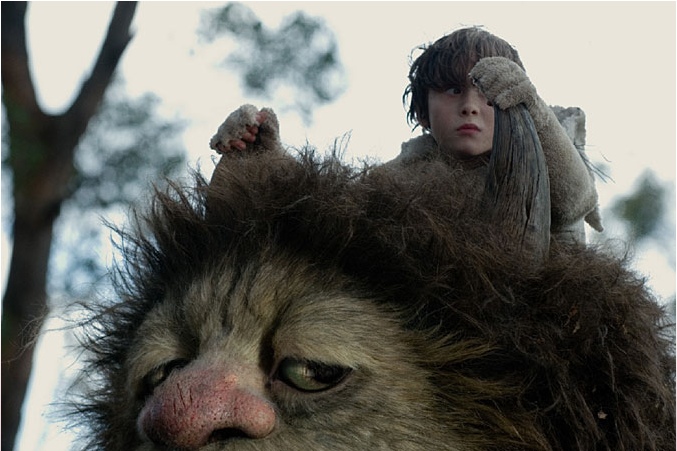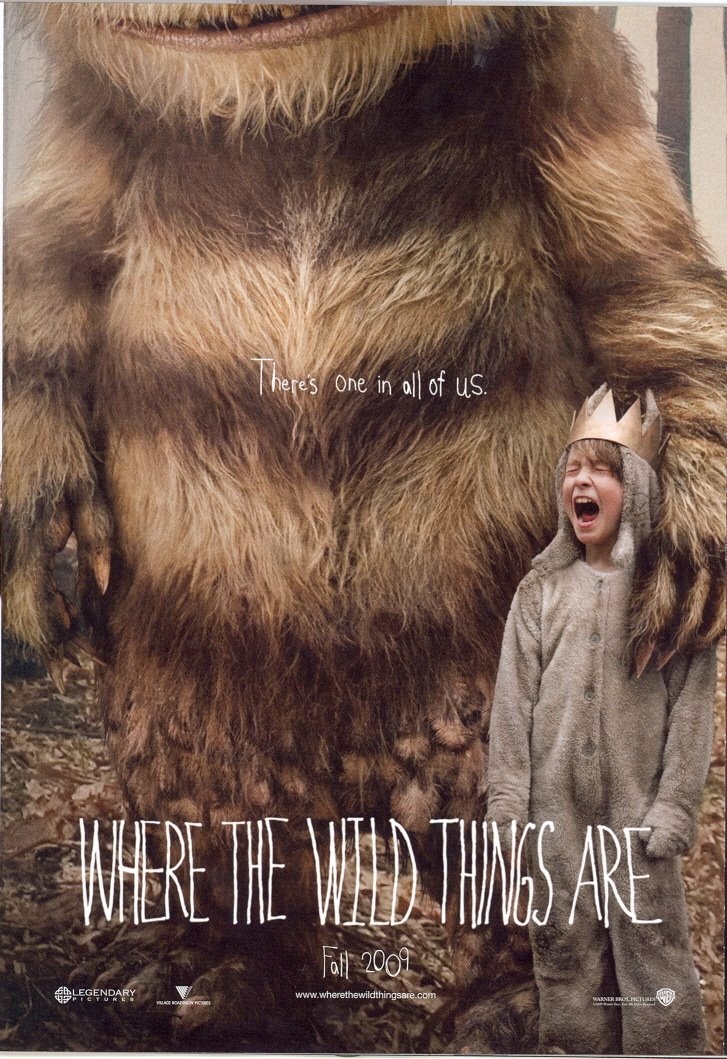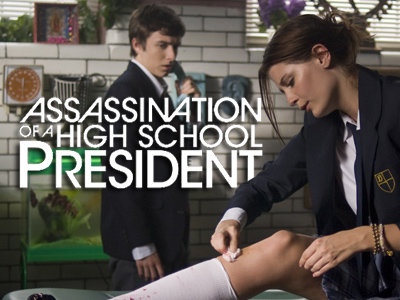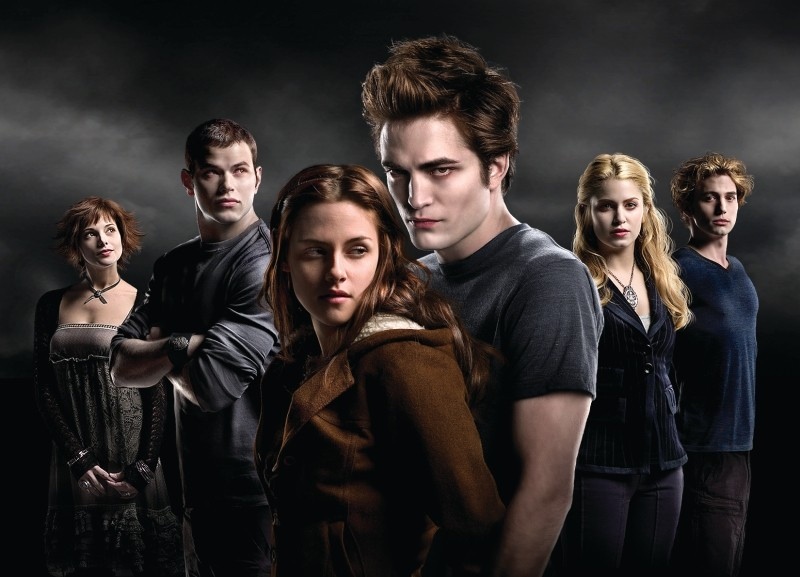A slow pace down the streets of suburban America, fireworks ablaze in the night sky, folks on the pavement feeling the atmosphere (and each other), all from the vantage point of a vehicle, and you know something's going to go wrong. The fully-demarcated beams of light cutting through the darkened fog from the mug of the same car now at lovers' lane says it is so. And it is true, but it's a rarity among cliches to rear its head in
David Fincher's
"Zodiac" which successfully averts most truisms of the serial killer genre to become a fine and handsome exploration of how the mythos of a monster escapes his own grasp and becomes the fare of the populace. This is the stuff of legends.
 Sgt. Mulanax (Elias Koteas), Inspector Armstrong (Anthony Edwards) and Inspector Toschi (Mark Ruffalo) question eventual suspect Arthur Leigh Allen (John Caroll Lynch).
Sgt. Mulanax (Elias Koteas), Inspector Armstrong (Anthony Edwards) and Inspector Toschi (Mark Ruffalo) question eventual suspect Arthur Leigh Allen (John Caroll Lynch).
The plot of the film, though titled
"Zodiac" after the killer who terrorized Northern California from the late-1960s to the mid-70s, is not about the man but his opponents, told in disjointed segments which fade to black every couple of minutes (and as short as two) to draw out a sort of detached view of the repercussions that begin to swirl. The framing device is almost episodic, each piece devoted to one setting and only a few of the handful of characters that come to dominate our perspective on the investigations, and unsheathing just one revelation, normally, in a fashion that's still more economical in filling in the details than most in the
serial killer archive. The film's running time is insignificant in its ability to conjure up a dense portrait of the people and places economically, to stitch them together to form a dynamic, and totally alive, entity. (I loved the references to the kids on Haight Street and on Castro, to
"Dirty Harry" and Steve McQueen, to the Altamont concert by the Rolling Stones on the radio, and to the construction of the
Transamerica building set against time and bad weather.) It is a city fascinated as it is frightened at the prospects of the killer's next unavoidable move. And while disjointed, the picture's still cohesive, progressive, each short segment offering ample visual flourishes to build a layered perspective of the lives that, ultimately, were built around these - let's face it - surprisingly few deaths. Letters, television screens, radio broadcasts, files, photographs. One stitch of shots showed Inspectors Toschi (
Mark Ruffalo) and Armstrong (
Anthony Edwards) in the safety of the police department, but entrenched in materials all related to the Zodiac killer: they can't escape him, he's seeped into every nook.
The segments become like the symbols etched in ink on the ciphers themselves in that they are bounded in time as the symbols are in space - allowing for fluid transitions to sometimes many years later - and they signify little when isolated. But taken together, as not a sentence but a three-dimensional agglomeration of history and reality, and theme for the sake of the movie, it chronicles just about every facet of the people in question, so that we may feel in our examination the horrific weight of a dead body, the terror of looking evil straight in the face, treading in a sea of his dark materials.
It's amazing what
Fincher is able to achieve in his visual and thematic reaches by using three (four if Armstrong is included) central characters as opposed to just one, and his inclinations towards generousness are sparse, so the decision is all the more atypical of him. Fincher's own
"Se7en" explored similar territory using a fictional serial killer who equipped a biblical motif to peddle his self-righteousness. But where that film used
Brad Pitt to explore the pressures of a world in moralistic transition, with
Kevin Spacey as both prophet and executioner of that movement in John Doe - a nod to the everyman at the heart of many a
Philip Roth novel who's caught in a perpetual struggle with
nihilism and the atrophying of his traditional morals - "Zodiac" invests in its heroes, and splices the themes of truth and accountability across its multiple characters to show its multitude of colors (its cleansing powers vested in
Jake Gyllenhaal's Robert Graysmith, its value as a commodity for
Robert Downey, Jr.'s Paul Avery, and the desperation for justice and balance in the endlessly book-abiding inspectors Toschi and Armstrong). Each somehow pays the price for betting in on the game to find the killer's identity, be it through family deterioration, career loss, psychological turmoil, the forfeiting of years from life.
 Paul Avery (Robert Downey, Jr.), the San Francisco Chronicle journalist, pre-alcoholism
Paul Avery (Robert Downey, Jr.), the San Francisco Chronicle journalist, pre-alcoholism The lack of a prevailing point of view on the side of the protagonists with instead a set of them beckons to
Fritz Lang's "M," showing us society's dance to flood all of the communication systems and caution the public about the evildoer's presence, although "Zodiac" does this within the
institutions of media and
police enforcement while "M" lodges itself at society's grassroots and the underworld below it. This dance - a veritable game of telephone - in which no one knows entirely the same things as everyone else, and no one knows exactly what's true at all, is practically the preliminary steps to the development of the urban legend. It is a choreography of gesture, word-of-mouth and broadcasts. But while "M" ends up empowering its serial killer by buckling itself to his perspective throughout his pursuit and in the subsequent trials which end in his persecution (and nearly execution), "Zodiac" obstructs any such attempt, keeping the killer an exaggerated version of himself. It becomes appropriate that a cartoonist, likely influenced by the aesthetics of the comics, would make the attempts at demystifying him both in illustration and in investigation, reaching the best conception on both terms.
The tenets of the urban legend, I think, elucidate a rather strange scene at the two-third mark of the film where Graysmith (
Gyllenhaal) follows a tipster back to his home, ultimately making their way into a very
unhealthily-lit basement.
Why was the theater operator framed in that way, dampened by rain and drenched in shadow, in one of those basements that's a rarity in California, staring down the Boy Scout hero, noises opening up out of the walls and ceilings like a chest filled with monsters? Was someone there? Was it intended only as the requisite scare-scene that's a staple in serial killer movies where a character finds it is their lack of keen insight or awareness that has finally doomed them? Fincher's parody of such stock sequences? It would have to be more than simply Graysmith's elevating levels of
paranoia as he further invests in the case, engrossing himself in demonic details of death and deviance, because Fincher's perspectival approach has up to this point and ensuing thereafter been detached, impartial, without predisposition (no, it only gives you enough reason to think it was Arthur Leigh Allen by film's end, it doesn't make the verdict for you). It would be inconsistent in a myriad of consistency, of strict restraint and immaculate discipline, for this to be so. The old man, then, must be parodying the
specter of the killer, no doubt keyed to the opportunity with Graysmith so obviously expressing his distress, a perfect moment to release all of the tensions that come with having lived in the same city and possibly worked in the same theater as the looming killer. You are not the killer, but you and the killer share a basement and writing styles. It's too easy. The lingering shot of the man as he stares down the boy, fingers fondling the light switch as he draws it down, is comical compared to the rest of the film's tone, intense only because it resembles our childhood memories of Scooby-Doo.
 The Zodiac's third couple: Bryan Hartnell (Patrick Scott Lewis) and Cecilia Shepard (Pell James) at Lake Berryessa in Napa County
The Zodiac's third couple: Bryan Hartnell (Patrick Scott Lewis) and Cecilia Shepard (Pell James) at Lake Berryessa in Napa CountyThere is also a brief scene in which Robert Graysmith confronts Arthur Leigh Allen (
John Caroll Lynch) for the first time in a hardware store after having courted the actual evidence through his acquaintanceship with the more experienced, and more self-obsessed, Paul Avery - and make no mistake, their short partnership was no fusion of friendship, it was a partnership only founded on the grounds of their common drive - and after having taken on the mantle himself, and romanced the idea of his being able to identify the killer after Avery's descent into drunkeness. It is rather short, simple, but wracked in tension, the
antithesis of a release - it raises the stakes in fact, the chess pieces assembling within their minds (if you do believe Allen's the killer, which could go either way given the manner it's so masterfully wrought in ambiguity). A friend of mine told me that he found the scene particularly hokey, like one of those payoffs where the hero needs not accomplish any real thing, he's satisfied
conceding defeat because he's learned a lot and knows he'll always keep the receipts of victory in his heart. But this isn't victory, this is a
vendetta, and his confrontation is not about holding the real truth in his heart, it is about laxing his
self-destructing obsession with a man he knows nothing about. (
"We know he reads the Chronicle," is what Graysmith's wife tells him, the only truth they ever attained.) He isn't conceding defeat, he is actively preventing his own implosion, something Inspector Toschi failed to do and what Paul Avery did too early given his talents (but in spite of his narcissism). Graysmith's ending severance is our realization that the deeds of some men can never be figured out because of our nature to imbue them with more power than they deserve (and if Zodiac was talented at anything, it wasn't killing, it was self-publicity), and that our derivation of reality is often composed of too many layers of bullshit. Reality, the world, is simply a harsh place, so let the youths sort it all out.
IMAGES from:
Livejournal
































